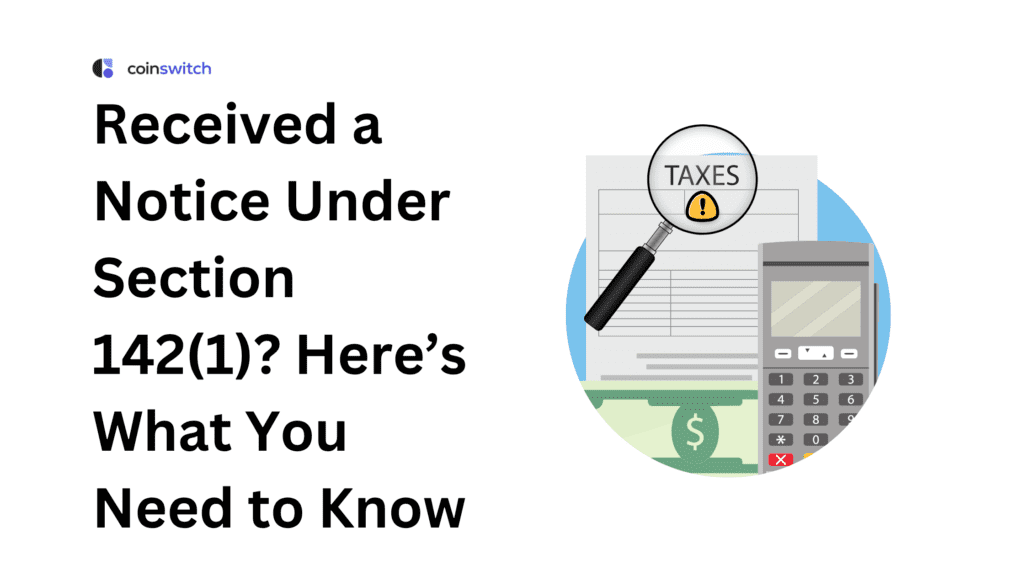Intimations from the taxman are not something we look forward to, yet sometimes we find ourselves at the receiving end. For instance, a notice under section 142(1) from the Income Tax department can appear scary. But there is no need to panic, as this is a regular procedure for income tax assessment. It is typically sent when the Income Tax Department requires additional information about your IT return or when you have not filed it yet. Such a notice can ask you to furnish income information, bank statements, deduction evidence, or other financial data.
As a salaried employee, owner of a business, or freelancer, it is essential to understand your rights and duties as a taxpayer. An income tax notice under Section 142(1) helps tax authorities enforce compliance. This blog post will inform you about the purpose of the notice, how to respond, and the required documents to be submitted.
Why Did You Receive This Notice
The notice may have been sent to you as the Income Tax Department wants some additional information before concluding your assessment. The most common reason is that you did not file your income tax return within the due date. When this happens, the department can request that you file the return by issuing an income tax notice under Section 142(1).
The second reason is that you may have forgotten to verify your return online within 30 days, even though you submitted it. In the absence of e-verification, the return is treated as not filed. In some cases, the Assessing Officer might request you to provide certain documents to support the income, deduction, or claim you may have on your return. These may be bills, receipts, or account statements.
Sometimes, you may also be required to give an explanation or give details about your assets and liabilities. This helps the officer gain a better understanding of your financial situation. The purpose of the notice is to make sure that your tax return is complete, accurate, and verifiable.
To be clear, an income tax notice under Section 142(1) does not imply that there is a mistake, but that the tax department requires more clarity or documentation. It is essential to respond to the notice promptly and provide accurate information.
Read More: Section 115BBH: Virtual Digital Assets Taxation Scheme (Cryptocurrency Tax)
Time Limit to Serve the Notice
Income tax notice section 142(1) may be used to issue a notice with a request for details or documentation to the taxpaying person. This is a notice typically issued after the return is filed. The Income Tax Act does not specify the exact time at which this notice should be issued. It is, however, sent out before the assessment is concluded.
If the taxpayer fails to respond within the required time, he/she may be subject to a penalty. One should always respond promptly to avoid any legal issues. The notice is issued to provide the officer with all the required information to enable him to carry out the assessment correctly and without bias.
Time Limit to respond
When you have been given a notice under section 142(1) of the Income Tax Act, you should act on it within a given time frame, and the time is generally within 30 days of notice. This notification is made when the Income Tax Department requires additional information on your income, expenditure, or paper records. One should also respond within the time limit to prevent penalties or other measures.
You just need to fill in your response online through your income tax e-filing account. Ensure that you retain a copy of your response and the acknowledgement for future reference. A prompt response means your case will be processed easily.
Key Details in the Notice
Income Tax notice section 142(1) is a legal instrument of the Income Tax Department under the provisions of the Income Tax Act, 1961. It grants authority to the Assessing Officer (AO), who may demand additional details or an explanation from the taxpayers. During the assessment, the issuing of this notice is common. It may be issued despite you having completed your filing under Section 139(1) or having not filed in the first place.
Read More: Section 194S of Income Tax Act: Everything You Need to Know
Who May Issue a Notice under Section 142 (1)?
The Assessing Officer is empowered to serve the notice under section 142 (1). This may happen with or without a filed tax return. If the taxpayer has not submitted the income tax return within the time frame mentioned in Section 139(1), the AO can issue a notice.
Such notice may even be served after the close of the concerned Assessment Year. There are scenarios where, although a taxpayer may not have an obligation to file a tax return, they may still be required to respond to the notice and file a tax return under Section 142(1).
What to Do in the Case of Receiving a Notice?
Receiving a notice from the Income Tax Department can be a stressful situation, and it must be handled correctly and promptly. Here is what you ought to do:
· Understand why you are getting a notice.
· Check the contents of the notice.
· Answer within the required period of time
· Present documentation, as specific documentation will be needed.
· If required, consult a tax professional for advice.
Demand for Particular Accounts and Documentation
The AO might require additional documents after receiving the income tax return to complete the assessment. These may entail evidence of deductions made, bills of expenses reported, or other supporting documents. This is intended to ensure that the information provided by the taxpayer is accurate.
The AO can request information about earnings from various sources, such as business, profession, or property. The taxpayer must ensure that the documents presented upon request are complete and accurate.
Other Necessary Information
Besides financial records, the Assessing Officer may request other information in writing. This may include explanations or notes related to any aspect of the return. For example, the AO might require an elaborate list of your assets and debts.
These may not necessarily be included in the books of accounts, but they would be helpful in the assessment. The information should be presented in the stated format and within the specified time as indicated in the notice.
Penalty for Non-Compliance
Non-compliance with the income tax notice section 142(1) is a serious matter. Under Section 271(1)(b), a fine can be charged at the rate of ₹10,000. The AO can also exercise the assessments under Best Judgement Assessment u/s 144, where the AO can exercise his judgement on the available information to determine your tax liability.
Prosecution for non-compliance under Section 276D can be initiated, where a person can be imprisoned with or without a fine, up to one year. When the case is more extreme, a search warrant may be allowed by Section 132 to implement a search operation.
How to Respond
To respond to a notice under Section 142(1) of the Income Tax Act, just follow the steps in the Income Tax e-filing portal:
· Log in to the portal by entering your PAN card details.
· Go to the Pending Actions tab and hit e-Proceedings.
· Select the View Notices and view your notice.
· Clicking on the button Submit Response will lead you to a different page.
· At this point, choose the type of Response on the notice.
· Use either of the two options, Partial Response or Full Response, depending on your case.
· Attach all documents required and submit your answer.
It is essential to respond within the timeframe specified in the notice. Delays can lead to penalties or lawsuits. If you are unsure of how to respond, consult a tax specialist.
Conclusion
Receiving an income tax notice under Section 142(1) can be stressful, but it is essential not to panic and act hastily. This is the notice that is typically sent to seek additional information or papers relating to your income or tax return. Log in to the e-filing portal and examine the notice on the e-Proceedings page. Early action can help avoid fines and make the experience hassle-free. Understanding what an income tax notice section 142(1) is intended to do can assist you in handling it better.
FAQs
1. How do I respond to the income tax notice (142/1)?
According to Section 142 (1), any response to a notice served must be submitted electronically and only through the e-Proceedings utility within the e-Filing accounts of the assessee.
2. What is Section 142(1)of the Income Tax?
Section 142(1) is a notice that requires taxpayers to provide documents and additional information about their income tax filing.
3. What is the time limit for issuing a 142 (1)notice?
No time limit is specified for issuing a notice under Section 142(1) of the Income Tax Act. This implies that the notice may be given even after the year of the relevant assessment is over.








